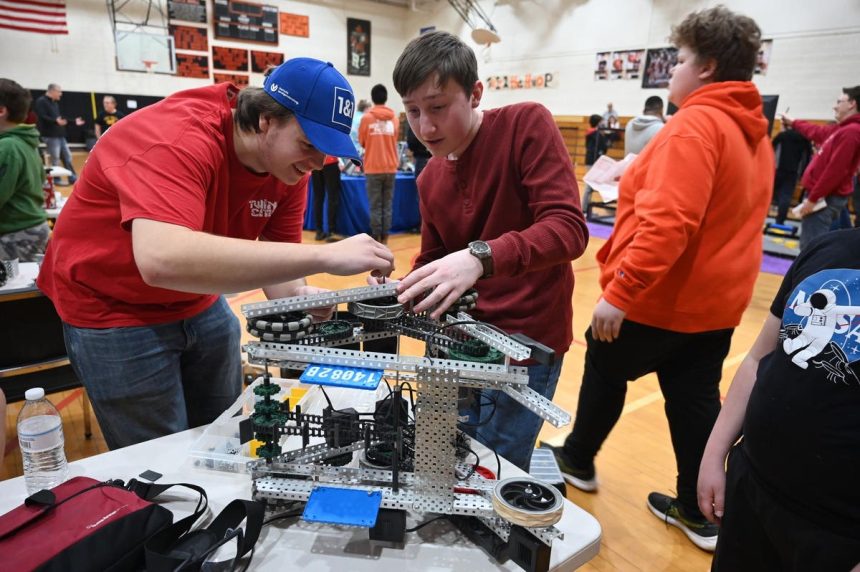While some schools struggle to create meaningful STEM programs (pro tip: handing students a computer and calling it STEM doesn’t quite cut it), one non-profit in Pennsylvania is helping spread rich, sustainable STEM programs throughout—and beyond—the state.
Rural Venango County sits in Northwestern Pennsylvania, midway between Pittsburgh and Erie. Back in 1859, the region was the site of the beginning of the oil industry. Now the Innovation Institute for Tomorrow, Inc. (II4IT) aims to move youth forward in the current technological revolution. With a tiny staff but a large web of connections, they have already worked with over 200 educators in 100 school districts to bring STEM to over 7,500 students.
II4T started simply enough. Tim Heffernan was a 7-12 gifted program teacher in the Franklin Area School District when two students came to him; they wanted to build a robot. He did some research, connected with some grants and other resources, and very quickly four robots escalated to 184.
He says his early goals were modest. “I tried to figure out how not to look like a fool.” He connected with experts at Carnegie Mellon University and Clarion University as well as local industries. The school hosted VEX Robotics competition events and brought in other schools to participate.
Full disclosure. I was an MC at one of those early events (held during the school day). It was exciting to see students engaged and involved as teams, winning admiration and accolades from peers for their robot building, coding, and battling skills (including students who were not necessarily standouts in other areas of school).
Several districts joined to form the Pennsylvania Rural Robotics Initiative, a consortium of Western Pennsylvanian districts, in 2018. Heffernan and PRRI continued to spread the robotics word, including serving with CMU on a team that produced a series of Robot Doctor videos with Pittsburgh’s PBS station, WQED (the original home of Mr. Rogers). Heffernan headed up that consortium while continuing on the school’s teaching staff, with the blessing and support of district administration.
But a change in superintendents resulted in a loss of district support for the Heffernan’s work with PRRI, and he faced a difficult choice. Stick with his steady, stable job, or continue the STEM work that was reaching so many students across multiple districts?
Hefferman chose the latter, and established II4T, which both continued and expanded on the work of PRRI.
II4T is able to host events and trainings, but much of their work is done helping school districts develop their own STEM programs. II4T helps mount robotics competitions and provides professional development for teachers interested in launching programs. They can offer training and experience in building and coding robots and drones. They’re developing a VR game to teach coding and an e-sports curriculum. They hold summer programs for students and summits for teachers and administrators.
Mostly, Heffernan says, they’re helping schools answer the question, “What can this look like for us?” Classroom teachers already carrying a full load don’t have the day-to-day time to figure out what the program can look like. “We help them figure it out.”
The more formally worded mission is on the website:
II4T works to advance K-12 STEM education by removing barriers and creating opportunities for both students and teachers. II4T has been successful in providing regional school districts these opportunities by partnering with K-12 Schools, Colleges and Universities, Business and Industry, Workforce and Economic Development Agencies, Nonprofits, and State and Local Government.
Heffernan serves as President and CEO, aided by program manager Steve Cutchall. The institute has an eight person board that includes representatives from local government, school districts, as well as regional and state representatives. They depend on a variety of grants and a wide network of people who believe in work they’re doing.
II4T continues to extend its reach; they’ll be traveling to Florida next to do provide some assistance.
II4T is housed in Franklin, PA, in the two floors above the Chamber of Commerce in space formerly occupied by the Masons. Just a few doors away, an historical marker notes the local attorney who made history creating the first trust for John D. Rockefeller. Across the street, a park is centered around a fountain raised well over a century ago by money made in the oil business. The region is filled with a rich history of the long-ago “valley that changed the world.” But in that upstairs space, II4T is helping schools navigate into a new future.
Read the full article here










